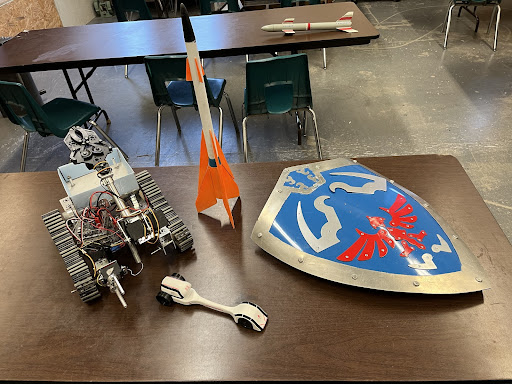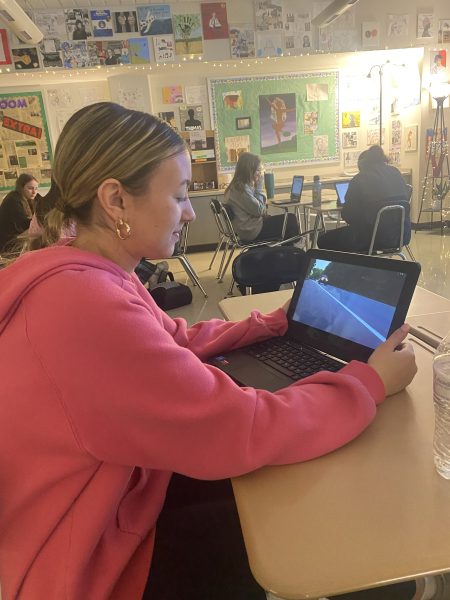Preparing for Success: The Pennridge STEM Department
There are many electives to choose from at Pennridge High School, and making your schedule for the upcoming school year can be a challenge. You only get to take two electives each year until senior year, so there is a lot of pressure in picking the electives you will enjoy most. The Pennridge STEM department offers 20 different electives which will give you knowledge and craftsmanship that will last you a lifetime. The program is consistently ranked at the top of the state. The school district received a $35,000 grant to the STEM department to prepare students and workers for an economy that requires proficiency in using computers and other technologies. No matter if you want a career in architecture, engineering, or carpentry, the STEM department has classes that will prepare you for these careers.
Woodworking
There are four levels of woodworking, with levels three and four being honors-level classes. Students are taught basic woodworking skills in the first level and do simple projects like a candle box. Students build on their skills from level one and do more significant projects like a blanket chess or coffee table in the second level. In level four, the students have the freedom to create whatever projects they want. “When you take a woodworking class, it is a lifelong experience. It teaches you how to use tools, home maintenance, and repair skills. Students love this class because it’s fun, fast-paced, and they build quality pieces that last a long time”, says Jim Rutkowski, a woodworking teacher at Pennridge. The other two woodworking teachers at Pennridge are Allen Androkites and Matt Peitzman. The guitar building classes are half-year classes that allow you to design your guitar or ukulele. You do not have to know how to play the instrument in this class.
Metalworking
There are two levels of metalworking and two levels of robotics taught by Hank Ward. In metalworking, Ward embraces creativity. “It is not about working with metal, it’s more about the process, it’s about creativity, it’s about problem-solving. In my class, you tell me what you want to make, so I open up that creativity and that personal touch more than a class that you’re told what to make,” said Ward. Working with metal may be scary, but you learn the proper techniques to do it safely. Robotics is all about the design loop. Students build the robot however they want and then solve problems to get a finished working model. This class also touches on different engines, aerodynamics, and space exploration, where students make models of rockets.
Computer-Aided Drafting and Design (CADD)
There are two levels of the CADD class taught by Robert Miller. “In CADD, you learn how to use computers to solve problems and generate virtual models of different objects,” Miller said when
explaining the class. When asked why students should take CADD, Miller says, “generally speaking, I think any computer application skill and being introduced to new technologies benefit everybody.” Students interested in construction, manufacturing, engineering, and architecture learn specific skills about how working drawings produce all products. Miller also teaches Architecture I, Architecture Commercial, and Architecture Green. In Architecture I, students learn to design preliminary plans to build a cottage. Building a cottage model is the final exam. Architecture Commercial and Architecture Green are half-year courses that follow Architecture I. In Architecture Commercial, students use skills from the previous course to design commercial buildings and floor plans. Architecture Green focuses on residential construction.
Conclusion
According to The U.S. Bureau of Labor Statistics, 2019–2029 employment projections show that occupations in the STEM field are expected to grow 8.0 percent by 2029, compared with 3.7 percent for all careers. Not only is STEM a growing field, the classes Pennridge offers teach you valuable skills like creativity, hard work, and craftsmanship. A goal of the STEM department is to grow the program and be more inclusive. Ward says, “I think a lot of students sometimes are a little bit scared of the stem programs, especially girls, and we’re trying to get over that stereotype. The girls I get in here usually love the course, and I think a lot more girls and anyone who doesn’t feel it’s within their comfort zone would find it very rewarding if they tried it”.
Gabe Daubert, Grade 12. Hobbies include running and golf. Gabe plans on attending either Penn State to study mechanical engineering and do ROTC or attend...












